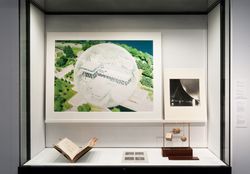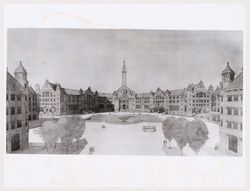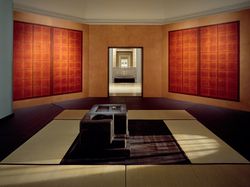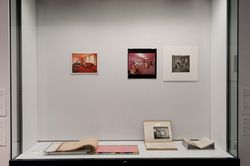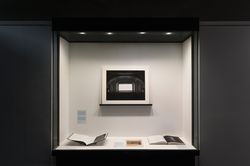La bulle constitue une merveille de tension superficielle. Dans son interprétation architecturale, elle peut être comprise comme une prouesse d’ingénierie ou comme la métaphore d’un environnement hermétiquement clos. En ce sens, la bulle apparaît, selon l’architecte Cedric Price, « quelles qu’en soient la forme ou la taille », comme un puissant symbole du futur, ou(...)
Vitrines
26 novembre 2009 au 17 janvier 2010
Sur les traces de... la bulle
Actions:
Description:
La bulle constitue une merveille de tension superficielle. Dans son interprétation architecturale, elle peut être comprise comme une prouesse d’ingénierie ou comme la métaphore d’un environnement hermétiquement clos. En ce sens, la bulle apparaît, selon l’architecte Cedric Price, « quelles qu’en soient la forme ou la taille », comme un puissant symbole du futur, ou(...)
Vitrines
chercheur en résidence, Pieter Uyttenhove, Le ville ouverte: De l'usage des métaphores épistémologiques en urbanisme
21 juillet 2000
photographies
Quantité:
82 photograph(s)
PH1996:0069:001-109
Description:
Group of 109 Polaroid photographs made by Aldo Rossi with some presented in the exhibition 'Luigi Ghirri - Aldo Rossi. Things Which Are Only Themselves' held at the CCA in 1996. The photographs represent several scenes from Rossi's travels in different countries: building façades, sacred images, billboards, houses from a Shaker village, baroque façades of churches (in Lecce, Italy), shops, street scenes, lakes, ports, showcases and furniture. Rossi's photography shows the interest he shares with photographer Luigi Ghirri in the belief in the autonomous eye of the photographer and in the potential of that eye to reveal something new to the architect. Ghirri sees in Rossi's Polaroids a "concealed passion, the 'secret' images of the architect, [...] puzzles that are solved with the heart". And according to his definition of photography, "a tangle of monuments, lights, thoughts, objects, moments and metaphors forming the landscape we are searching for in our minds... as would the points of an imaginary compass, which indicates a possible direction".
architecture, ingénierie, sculpture
1980s-1990s
Group of views of architecture from Aldo Rossi's trips to Italy, France, Corsica, Greece, United States and unspecified countries
Actions:
PH1996:0069:001-109
Description:
Group of 109 Polaroid photographs made by Aldo Rossi with some presented in the exhibition 'Luigi Ghirri - Aldo Rossi. Things Which Are Only Themselves' held at the CCA in 1996. The photographs represent several scenes from Rossi's travels in different countries: building façades, sacred images, billboards, houses from a Shaker village, baroque façades of churches (in Lecce, Italy), shops, street scenes, lakes, ports, showcases and furniture. Rossi's photography shows the interest he shares with photographer Luigi Ghirri in the belief in the autonomous eye of the photographer and in the potential of that eye to reveal something new to the architect. Ghirri sees in Rossi's Polaroids a "concealed passion, the 'secret' images of the architect, [...] puzzles that are solved with the heart". And according to his definition of photography, "a tangle of monuments, lights, thoughts, objects, moments and metaphors forming the landscape we are searching for in our minds... as would the points of an imaginary compass, which indicates a possible direction".
photographies
Quantité:
82 photograph(s)
1980s-1990s
architecture, ingénierie, sculpture
Série(s)
AP179.S3
Description:
Series 3, Tongxian Art Center, Beijing, 2000 – 2007, documents the development of a multiphase project for a public arts complex thirty miles from Beijing. Phases are distinguished when possible. Phase I of the project is the gatehouse (realized), which consists of housing and studio space for artists-in-residence. It is conceived as a brick monolith that has been shrink-wrapped or vacuumed into its shape – a metaphor for the optimization of the building’s limited space. Regional materials are incorporated through the use of local brick and native chudumu wood on the exterior. The gatehouse was completed in 2003. Phase II of the project is the art center (unrealized), which consists of public spaces, sculpture courts, administrative spaces and infrastructural needs of the institution, connected through a series of alleyways. The layout is organized to maximize interaction between inhabitants while maintaining a level of privacy. In addition to phases I and II, records in the series document a design referred to as Tongxian Gatekeeper (unrealized). Drawings, circa 2006, illustrate a building to house animals and agriculture in the southwest corner of the Tongxian Art complex grounds. The series contains sketches, drawings and reprographic copies from pre-design to construction stages of the project, two models including a wood model of the art center and a cardboard model of the gatekeeper wall, and photographic materials. The series also contains textual documents including correspondence with on-site project coordinator Timothy Clark, as well as meeting agendas, project schedules, agreements and proposals, and other project documentation. Digital material includes photographs of construction, CAD drawings, renderings, e-mail, and a video featuring the project team. The majority of material in the series relates to phase I of the project, the gatehouse. Some files include documentation about the involvement of contemporary artist Ai Wei Wei in a supervisory role for the project.
2000 - 2007
Tongxian Art Center, Beijing, China (2000 - 2007)
Actions:
AP179.S3
Description:
Series 3, Tongxian Art Center, Beijing, 2000 – 2007, documents the development of a multiphase project for a public arts complex thirty miles from Beijing. Phases are distinguished when possible. Phase I of the project is the gatehouse (realized), which consists of housing and studio space for artists-in-residence. It is conceived as a brick monolith that has been shrink-wrapped or vacuumed into its shape – a metaphor for the optimization of the building’s limited space. Regional materials are incorporated through the use of local brick and native chudumu wood on the exterior. The gatehouse was completed in 2003. Phase II of the project is the art center (unrealized), which consists of public spaces, sculpture courts, administrative spaces and infrastructural needs of the institution, connected through a series of alleyways. The layout is organized to maximize interaction between inhabitants while maintaining a level of privacy. In addition to phases I and II, records in the series document a design referred to as Tongxian Gatekeeper (unrealized). Drawings, circa 2006, illustrate a building to house animals and agriculture in the southwest corner of the Tongxian Art complex grounds. The series contains sketches, drawings and reprographic copies from pre-design to construction stages of the project, two models including a wood model of the art center and a cardboard model of the gatekeeper wall, and photographic materials. The series also contains textual documents including correspondence with on-site project coordinator Timothy Clark, as well as meeting agendas, project schedules, agreements and proposals, and other project documentation. Digital material includes photographs of construction, CAD drawings, renderings, e-mail, and a video featuring the project team. The majority of material in the series relates to phase I of the project, the gatehouse. Some files include documentation about the involvement of contemporary artist Ai Wei Wei in a supervisory role for the project.
Series
2000 - 2007
Selon une légende chinoise connue au Japon, une variété d’arbre, le katsura géant, avait été plantée sur la lune, d’où le proverbe : « Avec les yeux on peut voir le katsura, mais on ne peut avec les mains le toucher ». Cette maxime célébrant la quête d’un absolu traduit bien l’esprit d’Embarquement pour Katsura, qui poursuit cette recherche de l’identité et de l’idéal que(...)
Salle octogonale, vitrines et salle Sottsass
9 décembre 1998 au 28 mars 1999
Embarquement pour Katsura : Irene F. Whittome au CCA
Actions:
Description:
Selon une légende chinoise connue au Japon, une variété d’arbre, le katsura géant, avait été plantée sur la lune, d’où le proverbe : « Avec les yeux on peut voir le katsura, mais on ne peut avec les mains le toucher ». Cette maxime célébrant la quête d’un absolu traduit bien l’esprit d’Embarquement pour Katsura, qui poursuit cette recherche de l’identité et de l’idéal que(...)
Salle octogonale, vitrines et salle Sottsass
Sur les traces de... rose
Le traitement de la couleur en architecture est autant lié à ses aspects matériels qu’aux qualités sensibles qui lui sont reconnues : pouvoir évocateur, création d’une ambiance particulière, effets psychologiques distincts. Issus de la collection du CCA, des photographies, dessins, nuanciers et autres recettes chromatiques représentent, communiquent et imaginent ici la(...)
Vitrines
11 septembre 2009 au 17 janvier 2010
Sur les traces de... rose
Actions:
Description:
Le traitement de la couleur en architecture est autant lié à ses aspects matériels qu’aux qualités sensibles qui lui sont reconnues : pouvoir évocateur, création d’une ambiance particulière, effets psychologiques distincts. Issus de la collection du CCA, des photographies, dessins, nuanciers et autres recettes chromatiques représentent, communiquent et imaginent ici la(...)
Vitrines
Miroirs / Mirrors
Miroirs/ Mirrors prend forme à travers un dialogue indirect avec l’exposition L’histoire, par ailleurs: Go Hasegawa, Kersten Geers, David Van Severen, qui prend racine dans les références et les résonnances partagées entre les travaux de deux pratiques contemporaines mises en présence de l’histoire. Alors que L’histoire, par ailleurs se fonde sur limpression que lon a du(...)
Vitrines
22 juin 2017 au 14 janvier 2018
Miroirs / Mirrors
Actions:
Description:
Miroirs/ Mirrors prend forme à travers un dialogue indirect avec l’exposition L’histoire, par ailleurs: Go Hasegawa, Kersten Geers, David Van Severen, qui prend racine dans les références et les résonnances partagées entre les travaux de deux pratiques contemporaines mises en présence de l’histoire. Alors que L’histoire, par ailleurs se fonde sur limpression que lon a du(...)
Vitrines
livres
Description:
184 pages : illustrations ; 24 cm.
Abingdon, Oxon ; New York : Routledge, 2019., ©2019
Metaphor : an exploration of the metaphorical dimensions and potential of architecture / [Simon Unwin].
Actions:
Exemplaires:
Description:
184 pages : illustrations ; 24 cm.
livres
Abingdon, Oxon ; New York : Routledge, 2019., ©2019
livres
Metaphors in architecture and urbanism : an introduction / Andri Gerber, Brent Patterson (eds.).
Description:
302 pages : illustrations, plans ; 23 cm.
Bielefeld : Transcript, ©2013.
Metaphors in architecture and urbanism : an introduction / Andri Gerber, Brent Patterson (eds.).
Actions:
Exemplaires:
Description:
302 pages : illustrations, plans ; 23 cm.
livres
Bielefeld : Transcript, ©2013.
livres
Description:
61 pages : chiefly illustrations (some color) ; 23 cm
New York : Rizzoli, 1988., ©1987
Design metaphors / Ettore Sottsass ; edited by Barbara Radice ; art director: Christoph Radl ; translated from the Italian by Huw Evans.
Actions:
Exemplaires:
Description:
61 pages : chiefly illustrations (some color) ; 23 cm
livres
New York : Rizzoli, 1988., ©1987
